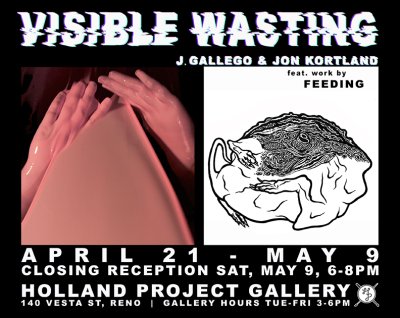Gallery Committee member and awesome artist Austin Pratt took a few moments to ask Jon Kortland some questions about his show with fellow artist J. Gallego that’s currently up at Holland. It’s called Visible Wasting and the Closing Reception is THIS SAT at 6pm. Check out Austin’s interview with Jon below, and then come hang with us on Saturday for the reception!
AP: You’ve developed such an iconic style over the years making art work for record covers for your own projects GOB and Iron Lung as well as for other bands; how do you think that graphic aesthetic translates in the gallery setting? Is any of the work in this show specifically distinct from the frame of mind that it might one day be a record cover, or does that matter at all?
JK: Thanks. I never really know how people perceive it. At this point, anything can end up in a gallery setting. I don’t always set out to make art to be used as a record cover. In fact, I and we (FEEDING) no longer do cover art for bands we are not directly involved with. I would say only about half of the work I do has no premeditated intention of becoming music related.
AP: What’s your current studio practice like? Is your visual work mostly with musical projects in mind, or? What’s a given day look like for you?
JK: I am constantly sketching and writing down ideas. If I don’t immediately get it down, it will probably go away forever. My memory banks aren’t what they used to be. I like to work on several pieces at a time. This way they can kind of evolve and inform each other as I work on them. My days usually contain some sort of creative practice whether it be art or music.
AP: You’ve mentioned your mentorship and influence from artist Michael Sarich at UNR both in your artist statement and in your last interview on the Holland Project blog. Is that something you bring up to connect with your history in Reno, or do you always consider his influence in your work? Can you talk a little bit about what that influence is and how it might permeate your work so many years later?
JK: I consider Michael a positive influence not only on my art, but on my life. He taught me how to work and what it means to create without limitations. I remember quotes he said on an almost daily basis. Though, they may have become twisted in my mind after all these years. His work spoke to me in a very profound way at a time when most, if not all, my instructors did not. I am just one of many people who have had a similar experience.
AP: More on that, what was censored in your exhibit at UNR? What happened, and is that Jay Leno story real?
JK: In the early ’90’s I had a show in the McNamara gallery called “Warm Towel.” The show had an opening and was up for a couple days then the board of regents deemed it obscene and demanded it be taken down. Most of the faculty and students stood behind me and this created a freedom of speech issue that started getting a lot of press coverage. Enough so, that Jay Leno read it during his weird news stories segment. I have never actually seen the footage, but a good amount of people told me they had seen it. If anyone out there has a vast Leno VHS archive…
AP: I feel that there are plenty of reasons that the impulse of punk in art and music is still important, but the strategies and tactics need to constantly shift in order to be effective. As someone who’s remained relevant and progressive in visual art, music, and in operating a highly lauded record label, what keeps you ahead? What’s next?
JK: I always remind myself that we live in a world full of complacency, a world that can often be a trap without any means of escape. Keeping that in mind, every option becomes available, every reason becomes valid.

